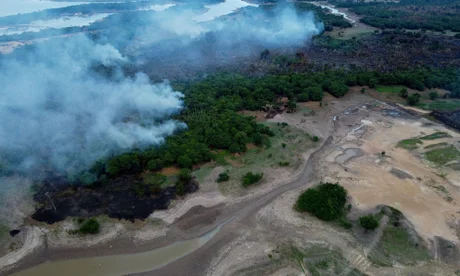Latest reports show that the Brazilian government has deployed almost 1,500 firefighters to the Amazon as the most severe drought in decades is turning the rainforest’s usually moist vegetation into kindling and flames.
There have reportedly been 59,000 fires in the forest since the start of the year, despite a sharp decrease in deforestation since the president, Lula da Silva, took power in January 2023. According to satellite data from the National Institute for Space Research, this is the highest number since 2008.
The unusually early fire season has engulfed the city of Porto Velho in smoke, prompting medical concerns about its 540,000 residents who are forced to breathe unhealthy air.
Commentators have said that the usual “flying rivers” of moisture above the world’s biggest rainforest have been replaced by plumes of smoke. There have already been devastating fires in another of Brazil’s great biomes, the Pantanal wetlands, which were made at least four times more likely and 40% more intense by human-caused climate disruption, according to a study by international scientists.
The environment minister, Marina Silva, also blamed human-caused global heating for the intense blazes. “We have seen a worsening of climate change. We had a period of El Niño, changes in the temperature of different regions, warming of the oceans, a series of issues that are aggravating the problems,” the minister said.
Read also: FG to reduce COP29 budget by N10bn
The government announced on Wednesday that it had mobilised 1,489 firefighters to combat the latest fires. In the past month, it said more than half of the wildfires in the north of Brazil had been extinguished or brought under control. But with the usual peak of the fire season in September and October, there are fears the situation could deteriorate further.
Ten Brazilian states have been affected. Federal authorities have asked the governors of Pará, Amapá, Roraima, Rondônia and Acre to decree a ban on the use of fire, which is often set by farmers to clear land. A ranchers union in Tucumã, Pará, said that its members had stopped using the method this year because they were alarmed by the tinder-dry conditions.
The Amazon Basin drought has been the worst in at least two decades. In July, the National Water and Sanitation Agency declared a critical water scarcity situation along the Madeira and Purus rivers. Many regions have recorded unusually low rainfall since last year, when the two great rivers that intersect at Manaus, the Solimões (the name given to parts of the upper Amazon) and Negro, fell to their lowest levels since records began 122 years ago.
Story was adapted from the Guardian.
